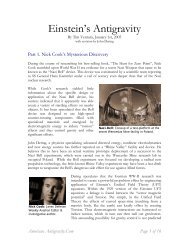Warp Drive Underwater - Signal Lake Venture Fund
Warp Drive Underwater - Signal Lake Venture Fund
Warp Drive Underwater - Signal Lake Venture Fund
You also want an ePaper? Increase the reach of your titles
YUMPU automatically turns print PDFs into web optimized ePapers that Google loves.
How Supercavitation Works<br />
GUIDANCE WIRE<br />
WATER FLOWING RAPIDLY around an object causes the fluid pressure to fall. At speeds beyond about 50 meters per second, the pressure drops<br />
sufficiently to allow the water to dissociate into water vapor, forming a gas bubble behind the object (cavitation). When the gas bubble fully<br />
encloses the object, it is called supercavitation. Slender axisymmetric bodies, such as the high-speed Russian Shkval torpedo (above) create long<br />
ellipsoidal supercavities. High-velocity fluid flow (from the right) produces supercavitation above the top surface.<br />
Other experts point to the possibility of fielding long-distance,<br />
multistage supercavitating torpedoes/ missiles fitted with<br />
nuclear warheads (“long-range guided preemptive weapons”)<br />
that could prove to be a relatively cheap and effective counter<br />
to future “Star Wars” missile defense systems. These devices<br />
could dash in from many miles out at sea entirely underwater,<br />
pop out of coastal waters close to their targets, and drop their<br />
lethal payloads before any aerial or space-based defenses could<br />
react.<br />
Surprisingly, we now know of at least one supercavitating<br />
weapon that has existed for many years. In 1977, after more<br />
than a decade of research and development, the Soviet navy secretly<br />
introduced a rocket-powered torpedo called the Shkval<br />
(Squall) that can “fly” through water at 100 meters per second<br />
(about 230 miles per hour) or more inside a self-generated gas<br />
cavity. Although this nuclear-tipped underwater missile is in<br />
some ways a bit crude and less than entirely effective, news of<br />
it in the early 1990s forced the Western military powers to take<br />
notice of supercavitating technology.<br />
There’s no doubt that many significant challenges beyond<br />
the merely technical would have to be addressed before any of<br />
these next-generation technologies achieves reality. Environmental<br />
concerns as well as navigation issues would have to be<br />
considered, for instance. Probably the biggest barrier to advancement<br />
would be finding sufficient capital to develop and<br />
build supercavitating marine systems. Nevertheless, history<br />
shows that military technology often finds financial support<br />
when money for other purposes is scarce.<br />
“Since very few of these things have been built so far, in<br />
many ways we’re at a stage similar to that of the airplane right<br />
after the Wright brothers first flew,” says Robert Kuklinski, an<br />
engineer and hydrodynamics research scientist at the Naval<br />
Undersea Warfare Center (NUWC) Division Newport in<br />
Rhode Island, the lead U.S. Navy laboratory investigating supercavitating<br />
systems. “But unlike then, we know a lot more<br />
about the underlying physics and technology than those early<br />
aerial pioneers did.”<br />
The Science of War: Weapons<br />
SUPERCAVITY<br />
Copyright 2002 Scientific American, Inc.<br />
SHKVAL TORPEDO<br />
Propelling a body through water takes considerable effort, as<br />
every swimmer knows. Speeding up the pace makes the task<br />
even harder because skin friction rises with increased velocity.<br />
Swimming laps entirely underwater is even more difficult, as<br />
water produces 1,000 times more drag resistance than air does.<br />
Supercavitation <strong>Fund</strong>amentals<br />
naval architects and marine engineers vie constantly<br />
with these age-old problems when they streamline the shapes<br />
of their hull designs to minimize the frictional drag of water<br />
and fit their ships with powerful engines to drive them through<br />
the waves. It can come as a shock, therefore, to find out that<br />
scientists and engineers have come up with a new way to overcome<br />
viscous drag resistance and to move through water at<br />
high velocities. In general, the idea is to minimize the amount<br />
of wetted surface on the body by enclosing it in a low-density<br />
gas bubble.<br />
“When a fluid moves rapidly around a body, the pressure<br />
in the flow drops, particularly at trailing edges of the body,”<br />
explains Marshall P. Tulin, director of the Ocean Engineering<br />
Laboratory at the University of California at Santa Barbara and<br />
a pioneer in the theory of supercavitating flows. “As velocity<br />
increases, a point is reached at which the pressure in the flow<br />
equals the vapor pressure of water, whereupon the fluid undergoes<br />
a phase change and becomes a gas: water vapor.” In<br />
other words, with insufficient pressure to hold them together,<br />
the liquid water molecules dissociate into a gas.<br />
“Under certain circumstances, especially at sharp edges, the<br />
flow can include attached cavities of approximately constant<br />
pressure filled with water vapor and air trailing behind. This<br />
is what we call natural cavitation,” Tulin says. “The cavity<br />
takes on the shape necessary to conserve the constant pressure<br />
condition on its boundary and is determined by the body creating<br />
it, the cavity pressure and the force of gravity,” he explains.<br />
Naval architects and marine engineers typically try to<br />
avoid cavitation because it can distort water flow to rob<br />
pumps, turbines, hydrofoils and propellers of operational effi-<br />
SCIENTIFIC AMERICAN SPECIAL ONLINE ISSUE 31





